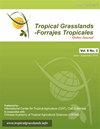氮肥施用时间对热带牧草响应的影响
IF 0.7
4区 农林科学
Q3 AGRICULTURE, DAIRY & ANIMAL SCIENCE
引用次数: 2
摘要
氮肥的施用时间可以影响草的再生,因此确定热带草对落叶后延迟施肥的反应是很重要的。我们的目的是确定收获后氮肥施用时间对3种热带禾草的生产、形态形成和结构特征的影响:答案:a。[au:]斯塔夫xarasamis), ' Marandu ' (Urochloa brizantha [Hochst.]答案:a。[au:]斯塔夫马兰杜语)和“tanznia”(megthyrsus maximus)。的简历。坦桑尼亚)。试验在温室中进行,采用完全随机设计,收获后延迟5次施氮(0,3,6,9和12 d)。延迟施肥量对沙拉西姆和马兰度围栏草的饲料质量没有影响(分别为7.4和7.8 g/盆)。每分蘖叶数和叶片出现率呈线性降低,分蘖种群密度和叶长随施肥延迟呈线性增加。随着施氮时间的推迟,坦桑尼亚的牧草质量(12.2 ~ 10.6 g/盆)、每分蘖叶数(3.1 ~ 2.6片/分蘖)和牧草积累率(0.47 ~ 0.41 g DM/d)呈线性下降,但分蘖种群密度(25分蘖/盆)不受影响。根据我们的研究结果,坦桑尼亚几内亚草应在收获后尽快施用氮肥,最好在收获后3天内施用,而xarasamas和Marandu则没有这样的紧迫性,延迟施肥可达12天而不会造成明显损害。在广泛推荐之前,这些建议需要在实地研究中进行检验。本文章由计算机程序翻译,如有差异,请以英文原文为准。
Effects of timing of nitrogen fertilizer application on responses by tropical grasses
Timing of nitrogen (N) fertilizer application can influence grass regrowth, so it is important to identify how tropical grasses respond to delays in applying fertilizer after defoliation. Our objective was to identify the effects of timing of N fertilizer application after harvest on the productive, morphogenic and structural characteristics of 3 tropical grasses: ‘Xaraés’ (Urochloa brizantha [Hochst. ex A. Rich.] Stapf cv. Xaraés), ‘Marandu’ (Urochloa brizantha [Hochst. ex A. Rich.] Stapf cv. Marandu) and ‘Tanzânia’ (Megathyrsus maximus [Jacq.] cv. Tanzânia). The experiments were performed in a greenhouse, in a completely randomized design, with 5 delays in applying N after harvesting (0, 3, 6, 9 and 12 days). Delaying fertilizer application did not affect the forage mass of Xaraés and Marandu palisade grass (7.4 and 7.8 g/pot, respectively). There was a linear decrease in number of leaves per tiller and leaf appearance rate, but tiller population density and phyllochron increased linearly as fertilizer application was delayed. Grass forage mass (12.2‒10.6 g/pot), number of leaves per tiller (3.1‒2.6 leaves/tiller) and forage accumulation rate (0.47 to 0.41 g DM/d) of Tanzânia guinea decreased linearly as N application was delayed, but tiller population density was unaffected (25 tillers/pot). Based on our results, N fertilizer should be applied to Tanzânia guinea grass pastures as soon as possible after harvest and certainly before 3 days, while there is not the same urgency with Xaraés and Marandu where fertilization could be delayed up to 12 days without significant detriment. These suggestions need to be tested in a field study before being recommended widely.
求助全文
通过发布文献求助,成功后即可免费获取论文全文。
去求助
来源期刊

Tropical Grasslands-Forrajes Tropicales
Agricultural and Biological Sciences-Agronomy and Crop Science
CiteScore
1.60
自引率
0.00%
发文量
36
审稿时长
16 weeks
期刊介绍:
The Journal publishes, in English or Spanish, Research Papers and Short Communications on research and development, as well as contributions from practitioners (Farmer Contributions) and Review Articles, related to pastures and forages in the tropics and subtropics. There is no regional focus; the information published should be of interest to a wide readership, encomprising researchers, academics, students, technicians, development workers and farmers.
In general, the focus of the Journal is more on sown (''improved'') pastures and forages than on rangeland-specific aspects of natural grasslands, but exceptions are possible (e.g. when a submission is relevant for a particularly broad readership in the pasture and forage science community).
The Journal will also consider the occasional publication of associated, but closely related, research in the form of an additional scientific communication platform [e.g. a re-make of the former Genetic Resources Communication series of the former Division of Tropical Crops and Pastures of the Commonwealth Scientific and Industrial Research Organisation (CSIRO), Australia].
Areas of particular interest to the Journal are:
Forage Genetic Resources and Livestock Production[...]
Environmental Functions of Forages[...]
Socio-economic Aspects[...]
Topics within the aforementioned areas may include: Diversity evaluation; Agronomy; Establishment (including fertilization); Management and utilization; Animal production; Nutritive value; Biotic stresses (pests and diseases, weeds); Abiotic stresses (soil fertility, water, temperature); Genetics and breeding; Biogeography and germplasm collections; Seed production; Ecology; Physiology; Rhizobiology (including BNF, BNI, mycorrhizae); Forage conservation; Economics; Multilocational experimentation; Modelling.
 求助内容:
求助内容: 应助结果提醒方式:
应助结果提醒方式:


